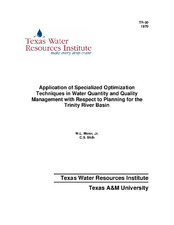| dc.description.abstract | One of the major problems in the United States today involves controlling and limiting the pollution of the nation's water resources. The quality of water in streams, reservoirs and estuaries is continually being altered by natural and man-made processes. Water development takes place as man seeks to alter the natural occurance of water and channel it to his use. Because water occurs in nature in places, times, and quantities different from the desires of man, reservoirs and aqueducts are built to smooth and tame the vagaries of nature. This alteration of the natural flow processes changes the stream regimen and affects environmental stream conditions.
In addition, the quality of water is altered as man uses it. Return flows from cities and industries contain waste constitutents in various concentrations which affect its suitability for further use. In the broadest sense, pollution can be thought of as any alteration of the quality of water. However, pollution is generally thought of as being some deliterious change in the water quality which renders it unfit for some particular use.
Effective water quality management is the goal of water pollution control activities in this country. Streams serve both as sources of water supply and avenues for the disposal of wastes. Thus, there is a clear interaction between quantity and quality of water. However, largely due to the agency structure in state and federal government, water quality management and water development activities are usually separated and often delegated to different agencies. As an example, in the State of Texas, the water quality control problems are the major concern of the Texas Water Quality Board, and the water development aspects are handled by the Texas Water Development Board. Although the professional personnel working within these agencies recognize the clear interaction between water quantity and quality, the present institutional structure is not necessarily conducive to the active consideration of this interaction. The State of Texas is not unusual in this regard as many states and the federal government have similar institutional arrangements. Even local governmental units are often formed in the same pattern.
The consideration of water quality management should be an integral part of water planning practice. Water resources planning involves the selection of physical works and operational procedures which will redistribute resources in time and space to satisfy demands for water. Consideration of water quality and quantity in water planning is increasing considerably. Because of past planning practice stemming from institutional structure and legislative directive, this consideration has not been widespread or comprehensive in nature up to the present time. Although there are many reasons for this, two are paramount. Firstly, the past solutions in which quality and quantity were considered separately have been adequate in most cases. As long as the needs for water were small in comparison to the total available supply or the water use and waste return points were widely separated, interaction of water quality and quantity was a local phenomenon. However, with population increase and a large increase in the demand for water has come the problem of degradation of water quality and more direct interaction of water quality and water quantity. Another reason for the failure to integrate water quality and quantity considerations completely in water planning activities stems from the complexity generated in the planning problems. Numerous methods for water quality management are in use or have been proposed. Some of these include direct waste treatment, in-stream treatment, retention and later release, flow augmentation, and others. Each adds a dimension of added complexity to an already difficult planning problem. This report describes a methodology which can be used in water planning to consider water quality and quantity interactions while remaining computationally tractable.
The purpose of this report is to provide an analytical framework based on the decomposition approach of dynamic programming within which it is possible to develop optimum water quality and quantity management plans. Emphasis will be placed on model development and diversity of applicability rather than highlighting a specific application. The model structure is developed and explained and example problems are formulated and solved. | en |


